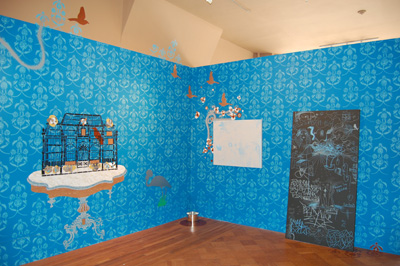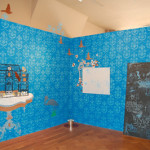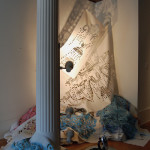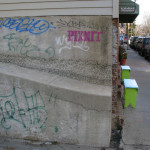It's difficult to find context within a polarizing issue. We see it now with our presidential election. Marked blocs of the country's population are congregating around different candidates because of beliefs, the way they understand the world, the paradigms that their psyches inhabit. War, guns, abortion, gender, race, same-sex marriage, to name a few, are the so-called hot-button issues that keep the indivisible permanently divided.
Graffiti, though not on the Supreme Court's docket, is no different.
Pixnit, a graffiti artist, street artist, or, as she prefers: simply ‘artist,' has created an installation at the Judi Rotenberg Gallery that funnels disparate peoples into one place both in terms of not only location but ideology. The Boston graffiti crew, ITD, (Illustrate Total Destruction or In Toy's Dreams) made their mark on a gallery-supplied ‘graffiti' canvas with their trademark circled ‘T' symbol while young lawyers and their infants were amongst the minglers at the show's opening on the 3rd of May.
It's not hard to understand why. The installation, "Hello My Name is Pixnit" is elegant and visually stunning. Pixnit coated the near entirety of the gallery with a comforting royal-blue and repeated a pastel-blue floral print throughout the space like wallpaper. It's not unlike walking into the aristocratic parlors of 17th-century France.
The installation is one of her stenciled "Spores" pieces combined with her stenciled ornamentations drawing on post-Renaissance French domestic designs gone unchecked by the institutions of private property and the law. Her unsolicited "Spores" can be found around Boston, Los Angeles, London, Paris, in places where one would likely find graffiti.
Rob "React" Larsen, a former graffiti artist, twice arrested, who works in the gallery realm these days said in his studio in Roslindale, "She's got those intricate stencils on these doors in the middle of Allston and it's fascinating because they're beautiful, really. They invoke 200 years of design and it's a stencil on a wall behind a bar in Allston. So the art is great and the place is even more fascinating and it's illegal, it just is… While it's probably not the kind of thing the cops are going to start hunting her down for, there's still that kind of subversive angle to it."
For those of us accustomed to seeing Pixnit's work on the street, the gallery space seems out of context for her, but her complex floral stencils in alleys in Allston feel awkward as well. We might, however, notice the occasional imperfections of spray-can mist on the edges of a hastily made stencil, reminding us of their illicit origin.
The saturation of the viewer's field of vision by the repetitive pattern helps the Pixnit's work transcend, if you will, the implicit context created by the white walls of a gallery. The work itself creates a context in the Rotenberg gallery by disguising the walls as art, but the grotesque trompe l'oeils created by life-size stencils of furniture and birdcages are clear signals that this is not just decoration. Though homages to the beginnings of graphic design and its entrance into domestic life in 17th century France, such as in the form of wallpaper, the politics of style and beauty and public and private - though less evident in the gallery than in the street - are present. Her stencils bleed onto the antique wooden floor of the gallery and an enormous stenciled chandelier swings to the side, permanently off-kiltered.
Pixnit has overcome the political polarization caused by her street works with "Hello My Name is Pixnit" by creating beautiful art, but outside the urban environment and off the street, her works lose the illegality that street art's political statement necessitates.
Pixnit said that she gets asked her legal work's legitimacy a lot. In an email, she said, "Defining graffiti solely by its illegality cripples its artistic value. It poses the same problem we get into when trying to define art. Placing parameters of legitimacy around graffiti limits its potential to impact our culture and the individual's experience of the work. There is no pure state of street art that is betrayed by its life in a gallery."
"I think graffiti in the gallery is great." Larsen said, "It's how you get there. Graffiti artists did it not to go into galleries, they did it for what it was. And it wasn't just something you thought you could do when you were 15-years-old in Boston." To reference street artists, the show's title "Hello My Name Is Pixnit," was printed on HELLO MY NAME IS stickers, a popular device for street art, at the opening and on the show's signage.
Law enforcement officials like Dennis King of Salem Police Department's Community Impact Unit doesn't like it. He said it's like the toy train sets that graffiti writers custom tag for their owners. Graffiti in art galleries "encourages illegal activity," he said in an interview at the Salem Police Department's headquarters. King received mention in the local press in February for his part in the nabbing of Adam Brandt who is alleged to be "Spek," a notorious graffiti writer who multiple police departments had been trailing for the past nine years. Graffiti became a felony in Massachusetts in 1995.
But let's not get ahead of ourselves. Talking to two individuals on two sides of a polarizing issue will do little to create a contextual framework through which we can understand an issue.
One aspect that makes street art successful is its open and unrestricted spirit. Whether you like it or not, it's meant for everybody. "Street art can be viewed by anyone in the public sphere," said Pixnit, "making it rather egalitarian in nature. However, the gallery presents another platform for viewing, one that expands the work even further into the fabric of our culture."
- “Hello my name is Pixnit,” installation view, spray paint stencil, 2008.
- Pixnit, Sporiferous, stencils from ten ‘Spores’ used in the creation of “Hello My Name is Pixnit,” 2008.
- A Pixnit tag, spray paint stencil, spring 2007, Photo by Jim Manning.
----
Pixnit Productions
Judi Rotenberg Gallery
Pixnit's "Folie que la nouveauté" at the DeCordova Museum
"Hello My Name is Pixnit" is on view through May 31 at the Judi Rotenberg Gallery.
All images are courtesy of the artist and Judi Rotenberg Gallery.






